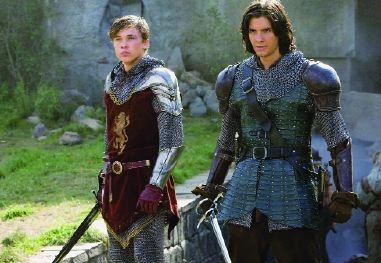The Chronicles of Narnia: Prince Caspian

Like The Lion, the Witch and the Wardrobe (2005), the first nonanimated big-screen feature film based on C. S. Lewis’s Chronicles of Narnia books, Prince Caspian is visually spectacular, emotionally stirring and dramatically potent.
The four Pevensie children are called back to Narnia, where they once reigned as kings and queens (a year ago in Earth time, but thousands of years by Narnia reckoning) to join up with the heroic young Prince Caspian and claim the throne that his tyrannical uncle, King Miraz, usurped from Caspian’s father. Except for a flashback that explains Caspian’s legacy and upbringing, the novel is mostly a battle between Miraz’s army (the Telmarines) and Caspian’s, made up mostly of “old Narnians.”
Director Andrew Adamson, working with co-writers Christopher Markus and Stephen McFeely, reconfigured the narrative to begin with Caspian (Ben Barnes) escaping from a castle with the aid of his tutor, Dr. Cornelius (Vincent Grass), when Miraz (Sergio Castellitto) targets his life. The script is a canny interweaving of plot elements culminating in the alliance—not always a comfortable one—between the rightful heir to the throne and the Pevensies. They are the “sons and daughters of Adam” appointed by the great lion Aslan to release Narnia from the chains of a tyrant (the White Witch, played brilliantly in the last film by Tilda Swinton, who makes a brief but memorable reappearance here) and summoned by powerful magic at Caspian’s behest to help him do the same.
Adamson and his collaborators create opportunities for drama that Lewis didn’t worry about, like a scene in which Caspian confronts Miraz with the murder of his royal father. The Telmarines are distinguished in this movie by their dark, brooding looks and Spanish-accented English. The old Narnians are a marvelously disparate crew: dwarves like Trumpkin (the wry, delightful Peter Dinklage, diving to the bottom of his wine-barrel voice), bronzed centaurs with pre-Raphaelite manes, chivalrous mice decked out in outfits out of a Dumas novel, minotaurs of staggering physical strength and ghostly dancing trees.
In this version of Lewis’s allegorical tale, Aslan/Christ is the benevolent yet fearsome force that reanimates the pagan spirits while setting humankind, in its most cultivated form, to rule over them. The White Witch is the satanic tempter seeking to restore her foothold in Narnia. She doesn’t collaborate with the barbarian Miraz; it’s Caspian she approaches, through her servants—a hag and a werewolf.
As in the Lord of the Rings movies, even the best people are vulnerable to temptation. But that vulnerability is proof of their superiority: when Caspian finally meets Aslan (voiced by Liam Neeson) and tells the lion he doesn’t think he’s ready to ascend the Narnian throne, Aslan replies that such self-doubt is evidence that he’s the right choice.
The squabbling between Caspian and the eldest Pevensie, Peter (William Moseley), over how to fight the war against Miraz confirms that even heroes must conquer their own human failings. So does the reluctance of the next oldest, Susan (Anna Popplewell), to trust the instincts of the youngest, Lucy (the expressively gifted Georgie Henley), who has visions of Aslan permitted to none of the others.
The most inventive addition in the first Narnia movie was the decision to locate the Pevensies in England during World War II so that the battle for Narnia is implicitly linked with the fight to reclaim Europe from Hitler. The ubiquitous soldiers in the tube station in Prince Caspian suggest that London, to which the Pevensies have returned after their sojourn with their uncle in the country, is still war-torn—an idea that resonates when, back in Narnia, Lucy tries to befriend a bear, assuming it’s one of the old-Narnian talking sort, only to find it turning on her.
The film keeps reminding us of the frailty of life: Lucy realizes, with a shock, that everyone they knew in Narnia is now dead, and the battles generate real losses, something Lewis tended to understate. The movie contains an undercurrent of sadness, beginning with the unease of the four children in England as they struggle to reconcile themselves with their old lives after their years of ruling over Narnia. The theme of mortality felt everywhere in Prince Caspian gives this Christian fairy tale a poignancy that Lewis, for all the splendor of his invention, never caught.





